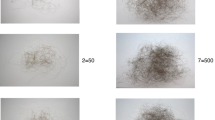Abstract
Hypertension causes cerebrovascular and cardiovascular diseases. To help prevent this, early detection requires continuous monitoring of blood pressure in daily life, which must be measured without contact. We previously proposed a noncontact technique for measuring blood pressure in which we evaluated the relationship between the variation in blood pressure caused by the cardiac-dominant pattern and facial skin temperature distribution using independent component analysis and multiple regression analysis. The mechanism of blood pressure change is roughly classified into cardiac-dominant patterns and vascular-dominant patterns. An elucidation of the relationship between these patterns and facial skin temperature distribution is the objective of this study. Two tests resulting in cardiac-dominant and vascular-dominant patterns were conducted. These common and different features related to each mechanism of BP change in each subject were then evaluated. The results of the tests show that similar features were extracted from the nasal region and contrasting feature quantities were extracted from the other facial regions. Hence, individual models were constructed for estimating blood pressure using the common features related to both mechanisms. A high coefficient of determination was obtained from these models, suggesting that models for estimating blood pressure caused by both mechanisms can be constructed using the proposed approach.












Similar content being viewed by others
References
GBD 2015 Obesity Collaborators (2017) Health effects of overweight and obesity in 195 countries over 25 years. New Engl J Med 377(1):13–27
Halme L, Vesalainen R, Kaaja M et al (2005) Self-monitoring of blood pressure promotes achievement of blood pressure target in primary health care. Am J Hypertens 18:1415–1420
Yong P, Geddes LA (1990) A surrogate arm for evaluating the accuracy of instruments for indirect measurement of blood pressure. Biomed Instrum Technol 24:130–135
Padilla JM, Berjano EJ, Sáiz J et al (2006) Assessment of relationships between blood pressure, pulse wave velocity and digital volume pulse. Comput. Cardiol. 2006:893–896
Ahn JM (2017) New aging index using signal features of both photoplethysmograms and acceleration plethysmograms. Healthc Inform Res 23(1):53–59
Gao M, Olivier NB, Mukkamala R (2016) Comparison of noninvasive pulse transit time estimates as markers of blood pressure using invasive pulse transit time measurements as a reference. Physiol Rep 14(10):e12768
Jain M, Deb S, Subramanyam AV (2016) Face video based touchless blood pressure and heart rate estimation. In: 2016 IEEE 18th international workshop on multimedia signal processing (MMSP). IEEE, pp 1–5
Uppal G, Prakash NR, Kalra P (2017) Heart rate measurement using facial videos. Adv Comput Sci Technol 10(8):2343–2357
Oiwa K, Bando S, Nozawa A (2018) Contactless blood pressure sensing using facial visible and thermal images. Artif Life Robot 23(3):387–394
Tanaka H, Ide H (1998) Study of stress analysis using facial skin temperature. J Robot Mechatron 10(2):154–157
Dvijesh S, Arcangleo M, Panagiotis T et al (2009) Imaging facial signs of neurophysiological responses. IEEE Trans Biomed Eng 56(2):477–484
Veronika E, Arcangelo M, Joshua AG et al (2014) Exploring the use of thermal infrared imaging in human stress research. PLoS ONE 9(3):125–136
Oiwa K, Nozawa A (2019) Feature extraction of blood pressure from facial skin temperature distribution using deep learning. IEE J Trans Electron Inf Syst 139(7):759–765
Okamoto R, Bando S, Nozawa A (2016) Blind signal processing of facial thermal image based on independent component analysis. IEE J Trans Electron Inf Syst 136(8):1142–1148
Oiwa K, Okamoto R, Bando S et al (2018) Blind source extraction of long-term physiological signals from facial thermal images. Artif Life Robot 23(2):218–224
Ito H, Bando S, Oiwa K et al (2018) Evaluation of variations in automatic nervous system’s activity during the day based on facial thermal images using independent component analysis. IEE J Trans Electron Inf Syst 138(7):812–821
Nakane N, Oiwa K, Nozawa A (2018) Attempt of estimating blood pressure by independent components of facial thermal image. In: 2018 annual conference on electronics, information and systems, GS9-7
Sawada Y (1993) Hemodynamic response. Kitaohjisyobo, Toyko (in Japanese)
Sawada Y (1993) Reproducible increases in blood pressure during intermittent noise exposure: underlying hemodynamic mechanisms specific to passive coping. Eur J Appl Physiol 67(4):367–374
Paul AO, Claude JG, Emily ST et al (1978) The relationships among heart rate, carotid dp/dt, and blood pressure in humans as a function of the type of stress. Psychophysiology 15(2):102–115
Porth CJ, Bamrah VS, Tristani FE et al (1984) The Valsalva maneuver: Mechanisms and clinical implications. Eur PubMed Cent 13(5):507–518
Mitsuishi H, Nagano Y, Takenaka K (2010) Long term psychological and cardiovascular reactivity to acute exercise. Jpn J Health Psychol 23(1):52–60 (in Japanese)
Sawada Y (1995) Cold pressor test at several water temperature: its hemodynamic mechanism raising blood pressure. Jpn J Physiol Psychol 13(1):39–47 (in Japanese)
Aapo H, Erkki O (1997) A fast fixed-point algorithm for independent component analysis. Neural Comput 9(7):1483–1492
Asapo H (1999) Fast and robust fixed-point algorithms for independent component analysis. IEEE Trans Neural Netw 10(3):626–634
Aapo H, Juha K, Erkki O (2005) Independent component analysis. Wiley, New York
Jiangang L, Hong L, Paul PZ et al (2018) Transdermal optical imaging revealed different spatiotemporal patterns of facial cardiovascular activities. Sci Rep 8(1):10588
Japan Society of Physiological Anthropology (1996) Human measurement hand book. Asakura Shobo, Tokyo
Acknowledgements
This work was partially supported by Aoyama Gakuin University-Supported Program “Early Eagle Program”.
Author information
Authors and Affiliations
Corresponding author
Additional information
Publisher's Note
Springer Nature remains neutral with regard to jurisdictional claims in published maps and institutional affiliations.
About this article
Cite this article
Nakane, N., Oiwa, K. & Nozawa, A. Relationship between mechanisms of blood pressure change and facial skin temperature distribution. Artif Life Robotics 25, 48–58 (2020). https://doi.org/10.1007/s10015-019-00565-7
Received:
Accepted:
Published:
Issue Date:
DOI: https://doi.org/10.1007/s10015-019-00565-7




